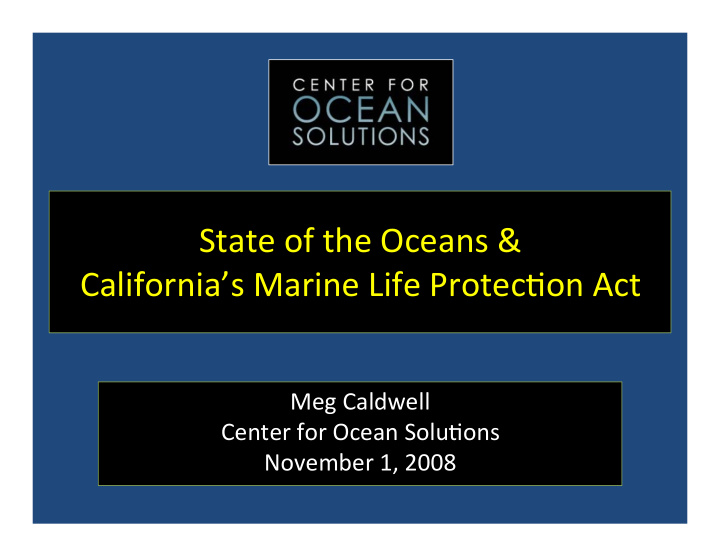



State of the Oceans & California’s Marine Life Protec6on Act Meg Caldwell Center for Ocean Solu6ons November 1, 2008
U.S. Commission U.S. Commission on Ocean Policy 2004 on Ocean Policy 2004 Pew Oceans Pew Oceans Commission 2003 Commission 2003
Major Threats to Our Oceans Nonpoint Source Pollution Point Sources Pollution Invasive Species Aquaculture
Major Threats cont’d Coastal Development Overfishing Habitat Alteration Bycatch Climate Change
A Collabora6on Across Disciplines and Ins6tu6ons
Pacific Ocean Ini6a6ve The Beginning Center for Ocean Solu6ons is a collabora6on between Stanford, MBAQ, and MBARI. We are an interdisciplinary group of over 80 social, physical and natural scien6sts whose mission is to elevate the impact of the sciences on ocean policy. Our goal is to find prac6cal, enduring solu6ons to the greatest challenges facing the global oceans. The Pacific Ocean 2020 Challenge Rescuing an Ocean in Crisis
Pacific Ocean Iden6fying Major Threats • Literature review – more than 3,400 papers covering more than 45 countries • Ve,ed by scien3sts represen3ng 30+ countries • Pacific Ocean Library (library.centerforoceansolu3ons.org)
Pacific Ocean Scien6fic Consensus Statement
Pacific Ocean Scien6fic Consensus Statement • Iden3fies the four most serious threats to the Pacific Ocean • The threats are persistent, widespread and increasing • The same for all countries and people around the Pacific • Provides the scien3fic founda3on for major policy change
Pacific Ocean Threats
Pacific Ocean Threats
Pacific Ocean Threats
Pacific Ocean Threats
Pacific Ocean Ini6a6ve: Looking Ahead to Solu6ons • Publish Meta‐Analysis • Advise IUCN on Pacific Ocean “Stern‐ Like” Report • Develop Pacific Ocean Conserva6on Trust Proposal • Nurture Community of Scien6sts • Advise Pacific “Heads of State” Mee6ng at CA World Ocean 2010
Before MLPA (& MLMA)… • “Incoherent” array of over 88 disjointed MPAs in state waters • Burden on pe66oner to prove need for an MPA • Tradi6onal fisheries management collides with ESA, MMPA… and itself and u_erly fails to integrate ecosystem principles
A2er MLPA (& MLMA) … • State has mandate to establish a network of MPAs in state waters by 2011 for improved ecosystem protec6on • Shi`s burden and places affirma6ve duty on the state to create MPAs • State’s fisheries managers have mandate to address ecosystem protec6on and now will be able to coordinate fisheries management plans with MPAs • Places California in forefront of marine resource planning in the U.S.
MLPA’s 6 Goals To protect the natural diversity and func6on of marine • ecosystems. To help sustain and restore marine life popula6ons. • To improve recrea6onal, educa6onal, and study • opportuni6es in areas with minimal human disturbance. To protect representa6ve and unique marine life • habitats. Clear objec6ves, effec6ve management, adequate • enforcement. To ensure that the state's MPAs are designed and • managed as a network.
Primary Designa3ons of MPAs in California : – State Marine Reserve (no take) – State Marine Park (no commercial take, but may allow/limit recrea6onal take) – State Marine Conserva3on Area (allows selected recrea6onal and commercial take)
MLPA • Is not a Fisheries Management Law • Requires use of “Best Readily Available Science”
MLPA Implementa6on 1999: MLPA becomes law 2001: $ but bad process 2002: be_er process but ran out of $ 2004 to present (MLPA Ini6a6ve): $, staffing, deadlines, poli6cal will, transparent public process
CA MLPA So Central Coast (2004‐07) CA Marine Life Protec6on Act Fish & Game MLPA Ini6a6ve Staff (incl. DFG) Commission General Public CA Dept. of Fish & Game Blue Ribbon Task Force Science Advisory Regional Stakeholder Team Group
Providing Science Guidelines & “Rules of Thumb” Size: minimum area of 9 sq. miles preferred area of 18‐36 sq. miles Spacing: no more than 30‐60 miles apart Habitat Coverage: all key habitats should be protected Replica3on: at least 3‐5 replicates of each habitat type
From This… Exis3ng MPAs in So Central Coast Region • 12 MPAs = 3.76% • 5 marine reserves = 0.65%
To This… • 29 MPAS = 18% of study region (204 sq.mi or 53,000 hectares) • 7.5% area in “no take” marine reserves, remainder mostly in moderate to high protec6on conserva6on areas
BRTF “Lessons Learned” Recommenda6ons for North Central Coast • Use a BRTF model for next region • Clarify roles of stakeholders, BRTF, DFG • Keep independent professional staff • Involve FG Commission earlier and more meaningfully with SAT, BRTF, RSG • Enhance state agency capacity: FG Commission; DFG; State Parks; SWRCB
CA MLPA North Central Coast Marine Life Protec6on Act MLPA Ini6a6ve Staff (incl. DFG) Fish & Game Commission General Public Blue Ribbon Task Dept. of Fish & Force Game Science Advisory Regional Stakeholder Team Group
North Central Coast Comparison of MPA Proposals
BRTF’s North Central Coast Integrated Preferred Alterna3ve From: 13 MPAs (1 marine reserve of 0.28 sq mi) 26.9 sq mi (3.54% of study region) To:
Vinaka! TThank You Thank you! h_p://www.dfg.ca.gov/mlpa/ For live video of all MLPA mee6ngs go to Cal‐span.org
Recommend
More recommend